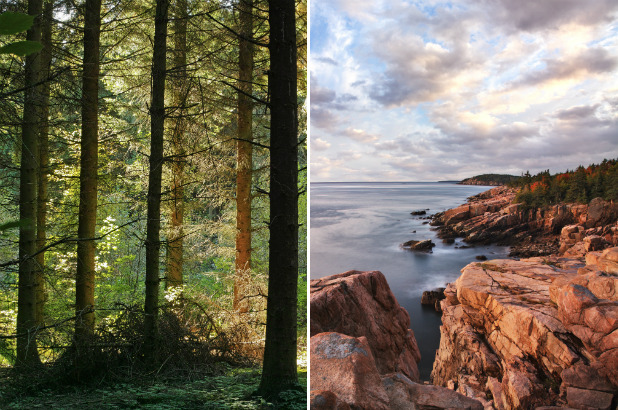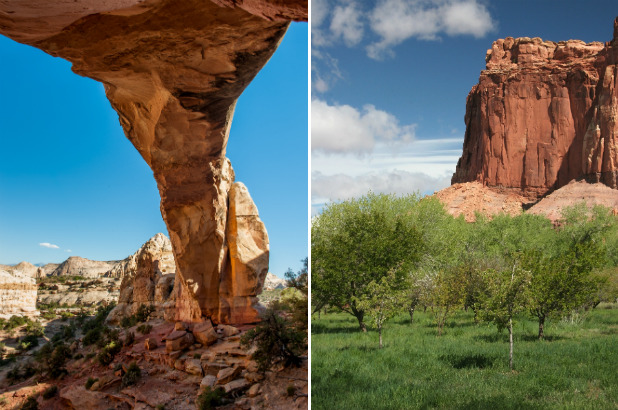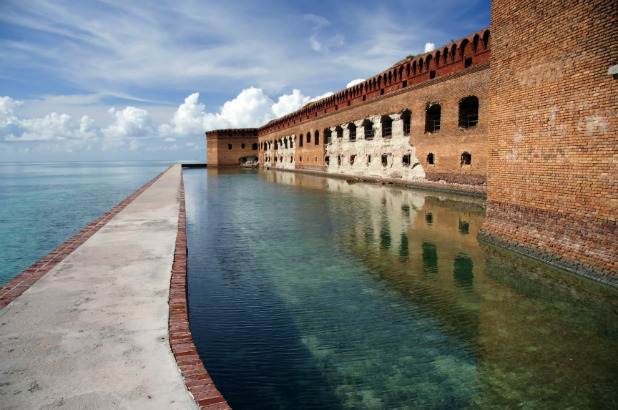12 Amazing National Park Campgrounds
Marked by jagged black rocks and oozing molten lava, Hawaii Volcanoes National Park boasts a notoriously rugged landscape. So it might come as a surprise just how cushy the camping experience can be here. In addition to 16 tent campsites tucked into a grassy eucalyptus grove, Namakanipaio Campground offers 10 A-frame cabins, which reopened last August after a complete renovation. But don't let the relative luxury fool you: The campground is still close to the action, only a half-mile walk from Kilauea's Halema'uma'u Crater, the home of Pele, goddess of fire and volcanoes. $15 for tent camping, $55 for cabins, reservations can be made at hawaiivolcanohouse.com
Click for more info.
As its name implies, Deep Creek Campground is all about the water. Located on the southern boundary of Great Smoky Mountains National Park, just north of Bryson City, this 92-site campground is centrally located for all kinds of freshwater activities. From your tent, you're a short hike away from three waterfalls: Juney Whank Falls, Tom Branch Falls, Indian Creek Falls. Campers can also rent inner tubes from just outside the park border to explore the pristine swimming holes and more thrilling whitewater creeks in this area. And Deep Creek is also a favorite among trout fishermen, who find brown, rainbow and brook trout in these waters. $17/night, open April 12 to October 31, no reservations.
Click for more info.
Only 12 miles from the mainland, Anacapa Island is the most accessible of California's Channel Islands. The chain of three tiny islets is composed of eroded volcanic rock, meaning you'll find steep sea cliffs, natural bridges and sea caves in place of sandy beaches. From the seven campsites on the east islet, you can access a surprisingly diverse landscape across the islands' combined 700 acres: hills that burst with red and yellow wildflowers in the spring, rocky shores filled with harbor seals and sea lions, tide pools teeming with starfish and sea urchins and the country's largest nesting colony of endangered brown pelicans. Offshore, the kelp forests near the Landing Cove can be explored by swimmers, snorkelers, divers and sea kayakers, who may also want to venture to the iconic Arch Rock and the island's lighthouse. $15/night, reservations can be made at recreation.gov.
Click for more info.
Yellowstone National Park has never been the kind of place where you could get away from the crowds—it rightfully ranks as one of the most popular parks in the country. But Slough Creek Campground is a different beast: A nearly two-hour drive from Old Faithful and hidden 2.2 miles down an unpaved road, this 23-site campground is the park's smallest, located out in the Lamar Valley near the northeast entrance. Popular with fly-fishermen looking to snag cutthroat trout, the valley also offers some of the best wildlife viewing in the park, especially if you're in search of elusive wolves and grizzlies. $15/night, open May 15 to October 31, no reservations.
Click for more info.
Don't let Blackwoods' size and accessibility fool you. Though this popular 306-site campground on Mount Desert Island is only five miles south of Bar Harbor and just off the main Park Loop Road, it remains remarkably peaceful even during summer high season. Set under the shade of pine, balsam and hemlock trees, Blackwoods is frequently cooled by sea breezes. Just a quick walk from camp you'll find postcard-worthy Little Hunters Beach, a stretch of polished cobbles and boulders at the base of a steep cliffside staircase. The more adventurous should consider a pre-dawn, four-mile hike up Cadillac Mountain, the highest point on the eastern seaboard and the first spot in America to see the sunrise each morning. $20/night May 1 to October 31, $10/night April and November, free December 1 to March 31, reservations can be made at recreation.gov.
Click for more info.
At 8,200 feet on the Kaibab Plateau and under a shade of ponderosa pines and aspens, this 90-site campground feels unlike anything you might find on the more popular South Rim, which receives 90% of the national park's visitor traffic. Up here, the weather's cooler, the amenities fewer and farther between and the vibe more intimate and insider-only. Best of all, unlike the South Rim's major campgrounds, this one actually offers campsites with direct canyon views: Sites 11, 14, 15, 16 and 18 overlook the Transept Canyon, well worth the small fee you'll pay for the premium location. $18-25/night, reservations can be made May 15 to October 15 at recreation.gov, walk-in October 16 to October 31.
Click for more info.
Set in a ponderosa pine forest abutting a wide-open meadow that fills seasonally with wildflowers, the Moraine Park Campground offers some of the most scenic views in the Rocky Mountains, with high peaks on nearly all sides. Though the grounds contain a whopping 245 campsites (about half of all those offered in the park's five campgrounds), the crowds don't seem to have scared away the animals. On the contrary, this is one of the most popular wildlife-viewing spots in the park: Mule deer and elk are a regular presence, but you may also have the chance to see coyotes, black bears, bighorn sheep and moose. $20/night, reservations can be made May 22 to October 8 at recreation.gov, walk-in other times.
Click for more info.
Desert oases don't come much sweeter. Surrounded by Capitol Reef's signature red rock cliffs, this 71-site campground is set amid historic orchards planted here by 1880s Mormon pioneers. Campers are invited to pick as many cherries, apricots, peaches and apples as they can eat while staying here—and there's a meager fee during harvest season to pick fruit in bulk to take home. Mule deer are often attracted by the fallen fruit and graze in the grassy meadows just beyond the orchard fences. In addition to the ancient petroglyphs, waterfalls, canyons and natural bridges that you'll find in South Utah's other desert parks, Capitol Reef boasts a uniquely human element from its early settler days, with an onsite one-room schoolhouse, a blacksmith shop and the Historic Gifford Homestead, where you can buy fresh-baked pies made from seasonal fruit. $10/night, no reservations.
Click for more info.
The desert-island digs on Garden Key are the definition of "primitive"—remember, for example, to bring everything you'll need during your stay, including your own freshwater. But you won't mind a bit with these wild surroundings, which are reachable only by ferry, seaplane or private boat from Key West, some 70 miles away. Located in the shadow of nineteenth-century Fort Jefferson, the 10 beach campsites offer uninterrupted access to the park's famed coral reefs, with amazing snorkeling opportunities at South Swim Beach and among the ruins of the South Coaling Dock. $3/person/night, no reservations.
Click for more info.
Perched among spruce trees on a bluff overlooking the Pacific coast, the 170-site Kalaloch Campground is the perfect vantage point from which to enjoy the Olympic Peninsula's wildlife-rich southwestern coast. The word Kalaloch means "a good place to land" in the local Quinault language, and the phrase certainly holds true for the many varieties of birds who nest here, including tufted puffins and bald eagles. Be sure to follow the trails or stairs that lead 40 feet down to the beach, where you can explore the tide pools brimming with anemones, crabs, starfish and sea urchins—which in turn attract the playful sea otters and harbor seals that frequent these shores. $14-18/night, reservations can be made June 20 to September 3 at recreation.gov, walk-in other times.
Click for more info.
Chances are the main attraction bringing you to Denali National Park is its namesake peak: At 20,320 feet, Denali (or Mount McKinley) ranks as the highest mountain in North America. For the best views of the snow-capped giant, you'll want to pitch your tent at Wonder Lake Campground, which is the farthest from the park entrance but the closest to what you came for. Though the mountain is still 26 miles away, it remains a stunning presence on the horizon at these 28 campsites near Mile 85 on the Park Road. The surroundings here are wet and boggy, meaning you're likely to encounter abundant waterfowl and beavers, plus the occasional moose or grizzly bear. $16/night plus $5 reservation fee, reservations can be made at reservedenali.com.
Click for more info.
Surrounded on all sides by rocky cliffs, the 60-unit Chisos Basin Campground manages to have surprisingly pleasant weather year-round, despite its location in hot, arid Southwest Texas. At 5,400 feet, the basin is at a higher elevation than the park's other campgrounds, meaning temperatures can often be 20º cooler here. The area is a popular nesting site for migratory birds, and the pinyon pines that grow here drop tasty seeds that attract pig-like javelinas. The nearby Window Trail leads to a scenic V-shaped canyon, and though the strenuous return trip is uphill the whole time, you'll have fields teeming with butterflies and dragonflies to keep you entertained most of the way. $14/night, reservations can be made November 15 to April 15 at recreation.gov, walk-in other times.
Click for more info.


